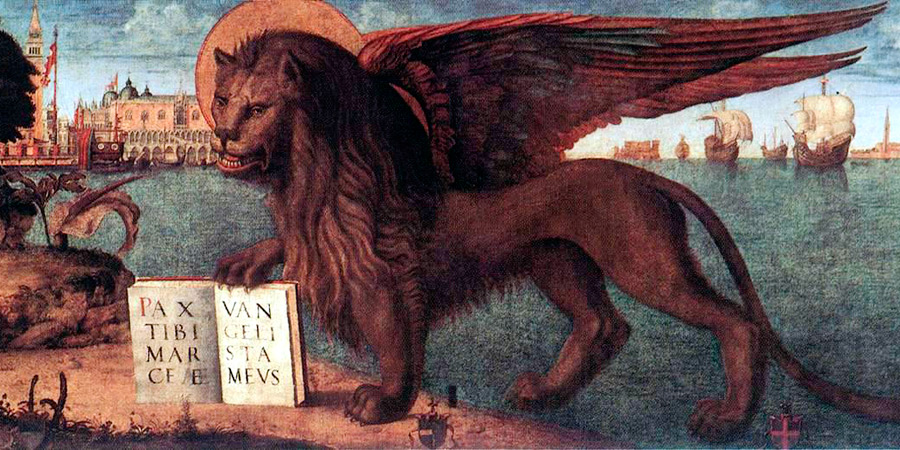The city of Venice is situated in 45º 26’ N. latitude, and 12º 20’ E. longitude, the longest day being fifteen hours and a half. It is only five miles distant from the Continent, and a long belt of land, called the Lido Maggiore, separates it from the Adriatic sea. The fortifications of the city are raised and disposed with great art upon twenty small islands formed by nature. From different points may be described banks of sand, called paludi or marshes, formed by the tides of the sea, and the gravelly soil brought down and deposited by the rivers Tagliamento, the Piave, the Brenta, the Adige, and the Po, all of which here pour fourth their waters into the Adriatic. The city is about six miles and a-half in circumference and contains two and a-half square miles. It consists at present of seventy-two islands of various extent, but in former times the islands amounted to 138; they are separated from each other by 150 canals, and connected by 450 bridges, of which 350 are of stone and 100 of wood; besides these there are 100 smaller constructions called traghetti, or foot bridges, to accelerate the communication between opposite banks, particularly on the Grand Canal.
Not less than twenty-eight thousand buildings, including palaces, churches, and other public edifices, have here been raised upon foundations of piles; these in times past were inhabited by a population of two hundred thousand, which is now reduced to about one hundred thousand. The changes produced by the course of time, have brought down Venice from her commanding position; but no change has deprived her of what may be truly called her native magnificence. Innumerable monuments prove to us the exalted power of the ancient republic, so often hailed by the name of 'Queen of the surrounding seas'. The climate is extremly mild and healthy. High and low tides by turns contribute to keep the city clean, but besides this, many machines called cavafango, or mud-pumps, are employed to cleanse the canals and carry off the filth so extracted; while the saltness of the water assists in keeping the temperature warm and pleasant The streets are generally kept in good condition; they were paved for the first time in the year (1226), during the government of Doge Ziani, and were completed upon a larger scale in (1334), under the direction of five directors, well chosen for the purpose. It might appear extraordinary to see stones of volcanic origin employed here, exactly similar to the old lavas of Vesuvius, blocks of which may be seen in some of the streets of Naples; but these stones, which are also doubtless formed of lava, are brought from the Euganean mountains, which, as well as a great portion of the province of Padua, formerly made part of a volcanic region. In buildings of large dimensions the better sort of a soft spongy kind of stone called Travertino is employed, and which is furnished by the mines of Padua and Istria.
It is unnecessary here to enlarge upon the politeness and sobriety of the inhabitants and their elevated manners, or upon the Venetian dialect of the Italian, unquestionably the sweetest and most pleasing of Italy, or finally upon the beauty of the women; these things are all well known. The Grand Canal, which takes a winding course through the midst of the city, divides it into two parts, which two parts are bounded by two splendid rows of palaces of consummate architecture, on each side. The Grand Canal has no foot-way upon its banks, and consequently the palaces seem to have arisen at once from the water, and are completely reflected in it as in a mirror. The principal entrances to these mansions are always towards the Grand Canal, and before them Gondolas, richly furnished and decorated, were always stationed to be ready for conveyance; and, generally speaking, it is only at the back of the buildings that smaller domestic doors are to be found. These last open into narrow streets and are made in the basement story. According to this peculiar plan Venice may be traversed either by water, or on foot by land. Alone in its greatness, the bridge of the Rialto seems to domineer in the sole possession of the Grand Canal, which it embraces with one spacious arch. Venice is adorned by a prodigious number of Churches, the most remarkable of which will be noticed here as well as the most celebrated Palazzi. The city has a colossal bridge over 600 arches that connects to the mainland. Venice will thus indeed lose much of that poetic charm that lingers among her palaces, but that charm can never die away entirely.
When the city had attained to its most extensive dimensions, and its bridges and canals were completed, (in 1072), it underwent a municipal division, and was defined into six districts, each of which on that account was denominated Sestiere, or a Sextain, three of these are upon the right, and three upon the left, of the Grand Canal. This civil division had been preceded by an ecclesiastical one, consisting of seventy-two parishes.
The Sestieri are thus enumerated:
- The Sestiere of San Marco, so called from the great Church of that name.
- The Sestiere of Castello, from the ancient name of Castello Olivolo which had been separated from the island of Rivo Alto.
- The Sestiere of Cannaregio, but commonly called Canareggio, or Cannareggio, from the vast quantity of reeds {canne) growing in those marshy parts not yet included within the city boundaries.
- The Sestiere of San Polo, pronounced commonly Polo, includes the high ground to the left, and in former time comprehended the Rivo Alto.
- The Sestiere of Santa Croce (Cross) from the church of Santa Croce in Luprio.
- Lastly, the Sestiere of Dorsoduro (hard back), so called from the form of the ground, and from its hardness, this being the rocky part of the lagune. This Sestiere was the last to be inhabited, being much exposed by its position to the barbarous attacks of pirates and corsairs, concerning whom so much is said in the chronicles of Venice.
The two islands lying nearest the city, that is Murano and Giudecca, the last formerly called Spina Lunga (the Long Ridge) were included, the first in the 5th Sestiere, and the second in the 6th Sestiere.
As this website is intended to help travellers intending to visit Venice, it is suggested that it would be useful to take care to divide the time destined for such a visit; and, after having taken a general view of the city, we would recommend him to hire a Gondola and make the tour of the Grand Canal. Thus leaving the Piazzetta, he will take the left side and return by the right. By this means he will have, in a few hours, the finest and most beautiful view of this renowned and magnificent city, which he can afterwards examine more particularly. He will then commence his observations on the three Sestieri, of districts, which lie upon the right of the Grand Canal, and which are those of St. Mark, Castello, and Canareggio. Afterwards he will take those upon the left, where are situated the remaining three Sestieri of San Polo, Santa Croce, and Dorsoduro. Four days may thus be employed in seeing the most important things in Venice.




